Abiotic factors greatly influence other parts of an ecosystem. They also impact the organisms living in that ecosystem. These are the non living parts of the environment.
The environment is a complex system made up of both live and dead components.
What is the other element of the environment? The non-living elements are known as abiotic factors.
These abiotic factors include sunlight, temperature, the presence of water, the type of soil, and air. Each of these factors has a different type of effect on the environment itself and organisms therein.
This is where abiotic factors come into play. Understanding them helps us see how ecosystems work. It also shows us how to protect them.
In this paper, we will look closely at abiotic factors. We will explore their roles and how they interact with living organisms. We will also discuss the ecosystems where they are found.
Table of contents
Understanding Abiotic Factors
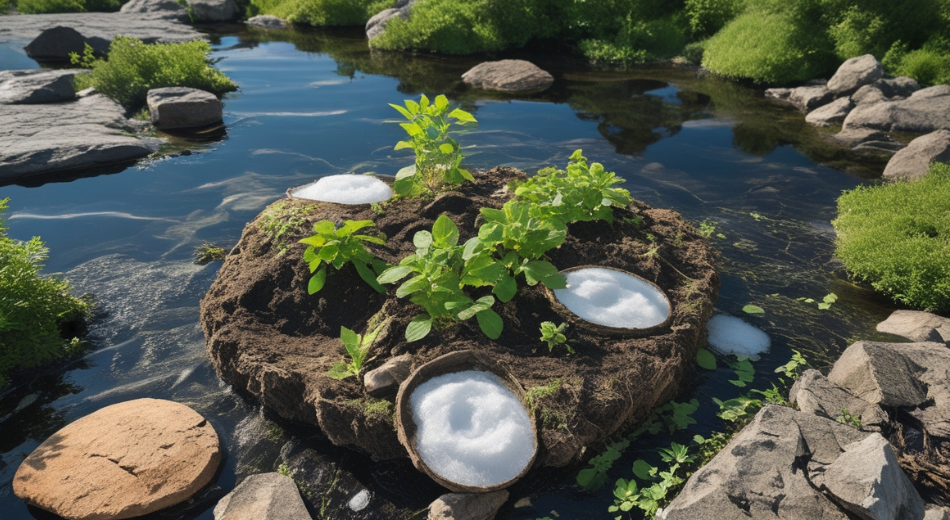
Abiotic factors are the non-living parts of the environment. They are not derived from living organisms. Rather, they are natural influences that shape environments.
Abiotic factors consist of both physical and chemical components. Examples of physical elements include temperature, light, and soil type. Interactions with chemical factors usually involve elements such as water, minerals, and pH.
The way living organisms of different species interact with their environment is shaped by abiotic factors. That is, it is determined by which organisms will be able to survive in any particular setting. For instance, plant growth in acidic soil conditions.
These factors do not work alone. They interact with each other and with living organisms. This creates a dynamic and complex ecosystem.
Abiotic factors also determine the distribution of organisms. Certain species can inhabit only specific types of environments. For example, polar bears exist in cold, icy regions due to temperature and ice conditions.
Until one understands abiotic factors, it is difficult to explain how ecosystems function. Abiotic factors provide the substrate on which living factors act.
Definition of Abiotic Factors
Abiotic factors, such as sunlight and temperature, are non-living components of the environment. They comprise factors and conditions affecting ecosystems.
These factors can be classified into several categories:
- Physical factors: Sunlight and temperature.
- Chemical factors: Minerals and pH levels.
- Geographical factors: Soil and topography.
Abiotic factors, such as sunlight, become energy sources critical for photosynthesis activity. Without sunlight, most plant life would not survive.
Chemical factors dictate nutrient availability. The soil’s acidity must be right for certain plant species. At the same time, salinity in water determines distribution among aquatic life.
Defining abiotic factors allows us to disentangle other elements and look at their effects. By understanding these elements, we can have a prediction of what ecological outcomes may occur.
Abiotic vs. Biotic Factors
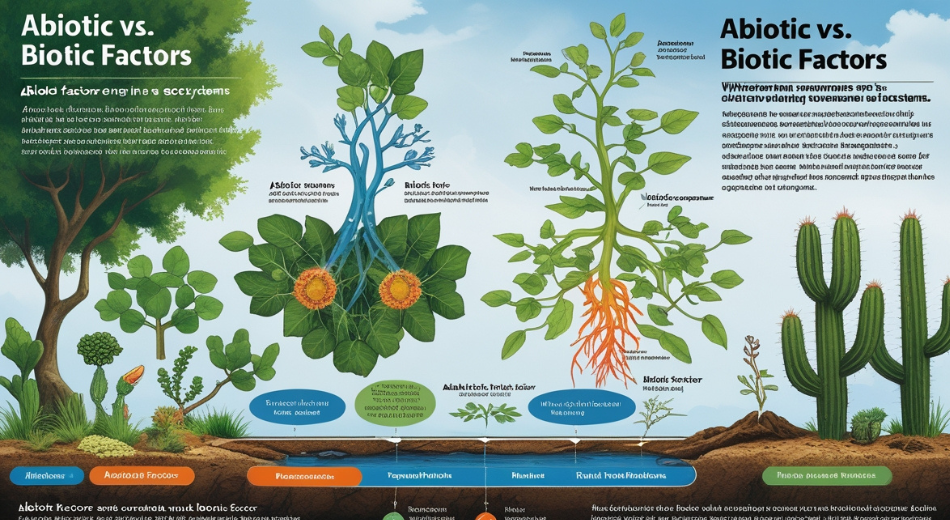
Abiotic factors are significantly different from biotic factors in that they deal with the living components of ecosystems. Abiotic factors include all the living organisms present in such ecosystems.
Biotic factors engage in diverse interconnections. They may be considered as producers, consumers, or decomposers within food webs. Such interactions govern energy flow and nutrient cycling.
Whatever, abiotic factors will strengthen the conditions of the environment. The chemical and physical parameters would mark the essentials such as temperature, light, and moisture. The biotic factors adapt to a certain level determined by abiotic parameters.
Both mutually control and constrain abiotic and biotic factors. The distribution of the biotic factor is usually limited due to the condition imposed by the abiotic. Cactuses grow with success in dry areas with aridity because of less reliance on water.
Acknowledging these differences maximizes the potential for carefully managing ecosystems. Understanding the relationship and balance is important for conservation efforts. It highlights how both are vital for ecosystem health.
The Role of Abiotic Factors in Ecosystem Dynamics and Functioning
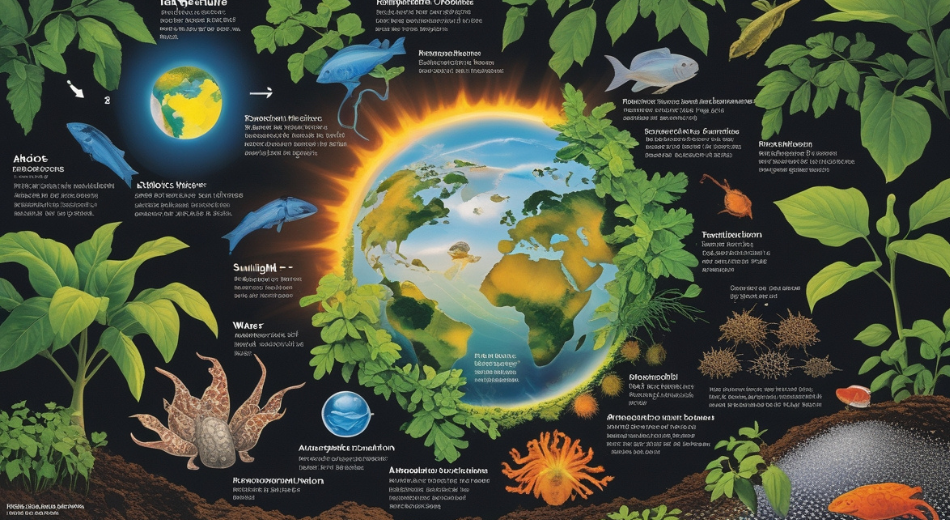
Abiotic factors are vital for shaping ecosystems as they set the basis and tiered conditions affecting all biological processes. These factors would provide a stage upon which life exists.
Temperature, for instance, influences metabolic rates in organisms. In addition, it greatly influences the geographical distribution of organisms. Warm climates usually support different sets of organisms compared with cooler populations.
Sunlight serves as an energy source for ecosystems. Its availability also determines plant growth and productivity. This, in turn, influences the food supply to herbivores and helps maintain the remaining food web.
Water is another critical abiotic factor. Its availability determines the organisms that can live in a given place. In general, aquatic environments are home to vastly different communities compared to arid deserts.
Soil type dictates diversity in plant species. The kind of soil affects its nutrient availability, and consequently affects the types of animals that can exist there.
Atmospheric composition and air quality also play a crucial role. These factors influence breathing and food production processes. Atmospheric conditions such as humidity and wind also modify transpiration rates in plants and influence seed dispersal.
Examples of Abiotic Factors
An abiotic factor or abiotic system is one that lacks biotic influence. Abiotic factors will differ in intensity in the respective ecosystems violating the ecosystem characteristics and functioning. Each factor accordingly contributes to the structure of the entire ecosystem in its own right.
Among the very common abiotic factors are included:
- Sunlight-which is important in the process of photosynthesis as well as determining the temperature.
- Temperature-that is realized to affect metabolism rates and extraction processes.
- Water: Essential to the sustenance of life, having a great bearing on the types of species that can be present.
- Soil: This most determines the kind of plant growth by virtue of the nutrients available.
- Air or atmosphere: Impacts the photosynthetic process as well as the climatic attributes.
Direct example-sunlight dictates plant growth. In a rainforest environment, the plentiful sunshine causes lush vegetation to abound. In contrast, deserts receive limited sunshine and therefore have sparse vegetation.
The availability of water completely transforms landscapes by creating lakes, rivers, wetlands, and supporting various aquatic life. In arid regions, dryness produces systems of drought-tolerant organisms.
Soil composition determines the types of vegetation that it can support. Fertile and rich soils will generally sustain fairly whole communities of plant species. In turn, poor and sandy soils might be capable of accommodating only certain hardy, adaptable plants.
How Abiotic Factors Influence Biodiversity and Ecosystem Health

The abiotic constituents of an ecosystem are thus fundamental to ecosystem health and biodiversity, being the circumstances under which life operates and evolves. The ecosystems may suffer when certain-most abiotic conditions are not supported.
Apart from the fact that biodiversity can be influenced by abiotic factors, temperature changes can do much more. Highly extreme temperatures may damage species that are not adapted to those conditions. Thus, species decline in number and variety.
Water influences plant and animal life directly and greatly. Areas with plenty of water have many plants and animals. Dry regions have fewer species and less biodiversity.
Soil minerals and other soil properties support, in their own right, how many and which organisms inhabit an area. With rich soils, there grows a varying plant life that supports the habitation of many organisms. With poor soil, the kinds and numbers of organisms are limited.
Abiotic factors likewise have a bearing on nutrient cycles. Such cycles function to support ecosystem processes such as growth, reproduction, and energy flow, among many others. Changes in nutrient supply may destabilize ecosystems due to the change in abiotic setting.
Thus, maintaining equilibrium among abiotic factors is crucial. Balanced conditions ensure preservation of ecosystem health and biodiversity. Biodiversity is protected through this equilibrium, and life is sustained in the ecosystems.
Abiotic Factors and their Impacts on Living Organisms
Abiotic factors are very much indispensable to living organisms. They create habitats and environments for life. In their absence, life has to face stiff challenges.
Each abiotic factor comes with its distinct impact on life. Temperature, for example, regulates many metabolic processes. It provides information on enzyme activity and physiological functions in organisms.
Water is the basic need for life. By virtue of its polarity, we can conclude that chemical reactions are facilitated through polar interactions. It mediates crucially with the environment, thus forming both aquatic and terrestrial environments.
Sunlight is responsible for energy acquisition by organisms. Accompanying a plant’s activity in photosynthesis, sunlight is energy important for plants. Sunlight also regulates biological cycles in higher animals.
The abiotic factors are not and cannot operate independently. They owe their synergy and combination to the fact that they make habitats unique to every local area. These interactions and combinations affect the establishment and adaptations of organisms to their environment.
The Impact of Temperature, Water, and Sunlight
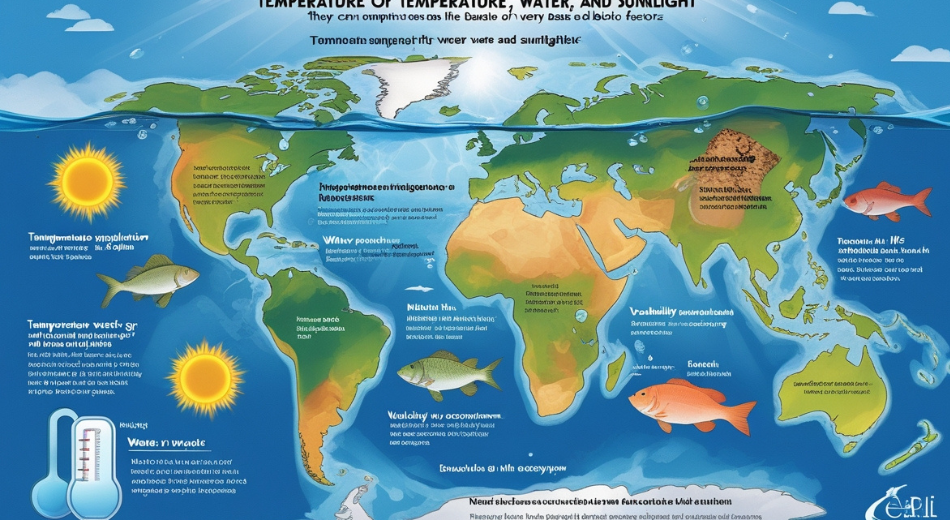
Temperature, water, and sunlight are basic abiotic factors. They constitute the very basis of life on Earth. Each factor plays some vital role.
Temperature influences temperature regulation in animals. It induces migratory and adaptive behaviour. Very high and very low temperatures can result in the death or physiological stress in an individual.
Water provides life; nourishes all organisms, and disperses nutrients. It maintains the aquatic habitats and its organisms. Variability in the availability of water can cause a drastic impact on the ecosystems.
Light is critical for photosynthesis; it enables plant growth and energy transfer. It influences seasonal behavioural patterns and life cycles in animals.
Together these factors work in harmony to amplify all ecosystems. Any change in them can disrupt the stability and functioning of the ecosystem. The balance ensures life is sustained and biodiversity.
Soil and Air: The Base of Terrestrial Life
Soil and air are fundamental to terrestrial ecosystems. They ensure plant growth and climatic control. These parameters are essential to terrestrial biodiversity.
Soil supplies nutrient and physical support to plant life. It affects root development and water retention. Soil composition decides how many species of plants would become established and grow.
Air is responsible for respiration in animals and photosynthesis in plants. It regulates temperature within the ecosystem and levels of humidity. Changes in air quality can affect health and ecosystem functioning.
Soil and air together lend an enabling environment. Energy flow and nutrient cycling are enabled by them. This is the foundation on which a variety of organisms can live.
Understanding these abiotic factors is very important in conservation. Preservation of soil fertility and air quality would save ecosystems. This is the heart of environmental management efforts.
Human Action on Abiotic Factors
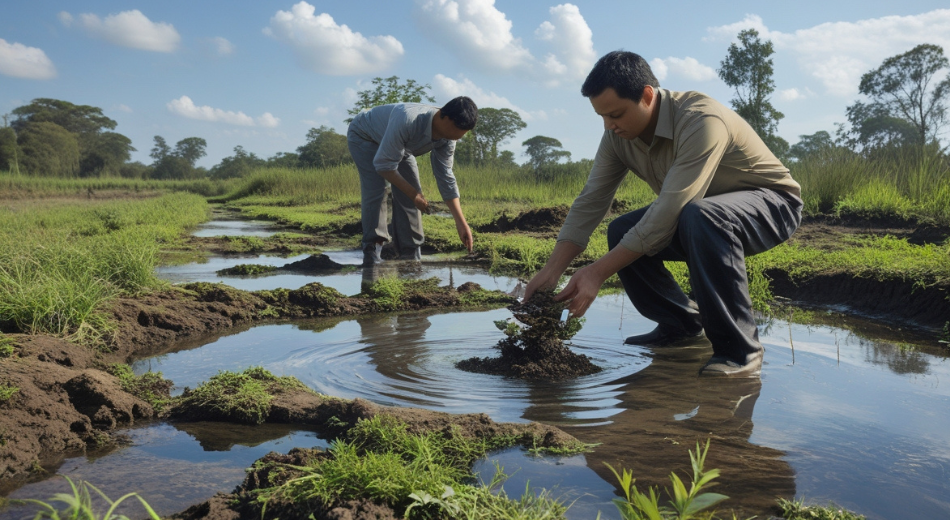
Human activities affect biodiversity through alterations in biotic factors.Industrial, urban, and agricultural activities change the natural environment. These changes can greatly impact ecosystems.
Pollution is probably the chief culprit in abiotic factor alteration. It affects the quality of air, difficulty in water, and soils such that florae and fauna are in discomfort. From Chemicals to disposables, these combine instead of balance the perfectly normal relationships under varying conditions.
Climate change aggravates abiotic alterations. Increased temperature and alteration in rainfall patterns put ecologies under stress. These shifts affect the distribution and behavior of many species.
Human intervention, at times, upsets the balance of an ecosystem. The abiotic alterations may adversely affect the quality of habitat. In so doing, it strengthens the negative forces against biodiversity and ecologic resilience.
Pollution, Climate Change, and Abiotic Stressors
Pollution provides its stresses on the environment. Air pollution causes smog and acid rain, damaging ecosystems. Water pollution networks affect aquatic habitats and species diversity.
Climate change will introduce long-term changes in abiotic conditions. It increases the likelihood of extreme forms of weather. Flooding and drought can create drastic changes in different habitats.
Abiotic stressors will influence survival and reproduction in organisms. One good case of acid rain changes soil pH and availability of nutrients. Such changes will hamper the growth of plants and the dynamics of any given ecosystem.
That is, to abate these stressors, loads of pollution must be reduced. Efforts toward CO2 emissions would slow climate change. Ecosystem protection requires a mode of operation that transcends national boundaries.
Conservation and Management of Abiotic Factors
Conservation of abiotic components is of utmost importance for ecosystem health. Well-articulated management gives support to both the restoration and outgrowth of an ecosystem into sustainability. This turns it into a platform for the preservation of natural habitats and biodiversity.
Restoration endeavours engage themselves with the repair of the unstable abiotic components. The process of improving soils will ordinarily enhance nutrient cycling and plant-growth. By greening actual drinking water, such works increase the value of aquatic habitats and contribute to species survival.
Sustainable practices diminish adverse human impact upon the abiotic aspects. Agriculture could put into practice water-saving, soil-friendly techniques of work. Making green spaces a part of urban planning can bring cleaner air.
Monitoring and research give important information to help with conservation. Understanding changes in the environment can lead to timely action. Multidisciplinary collaboration gives that benign solution to management challenging abiotic attributes.
Conclusion: Understanding the Importance of Abiotic Factors
The abiotic factors are the foremost components to be equally recognized for the sustainable functioning of an ecosystem. These non-living components of nature intervene directly in either enhancing the health or degrading the diversity of any living organism. Our comprehension of their exact roles will gradually inform us on what changes should be expected and how to develop the proper strategy for conservation.
Understanding the interactions of abiotically involved elements together with biotic ones will help preserve the ecosystem. These non-living parts of nature can either improve the health or harm the diversity of living organisms. We will slowly understand their roles. This will help us know what changes to expect. It will also guide us in creating the right conservation strategy.
References
- Smith, J. (2020). Ecology and Environmental Science. Greenfield Publications: This book offers a comprehensive overview of the dynamics of ecosystems focusing on abiotic and biotic interaction.
- Williams, R. & Thompson, L. (2019). “Abiotic Factors and Ecosystem Health”. The article in the Journal of Environmental Studies discusses the role of non-living parts of the environment. It explains how these elements support biodiversity. The article is found in volume 45, issue 3, pages 112-135.
- Jones, P. (2018). Understanding the Natural Environment. EcoScience Press: This book looks at different ecological factors. It shows how physical and chemical factors shape ecosystems.
- Nelson, A. & Carter, S. (2017). “Abiotic Factors: Effects on Species”. Ecosystem Review, 42(7), 190-205: This study looked at how non-living factors affect how species adapt and where they live.
- Park, C. (2021). Impact on Environment by Man. Global Solutions Publishers: This is a reference on anthropogenic effect on natural abiotic factors-through an analysis of various strategies to mitigate anthropogenic influence.
Author Info
Jane Doe is an environmentalist specializing in ecological research with over ten years of experience. She focuses on research on abiotic and biotic interactions in ecosystems.
She has a doctorate in Environmental Science and is a contributor to numerous scientific journals. She is passionate about education and communication, advocating public understanding for science and ecology as a whole.ating the public on ecological sustainability and conservation.




Just thinking about you gives me chills… come closer – https://rb.gy/es66fc?dyer